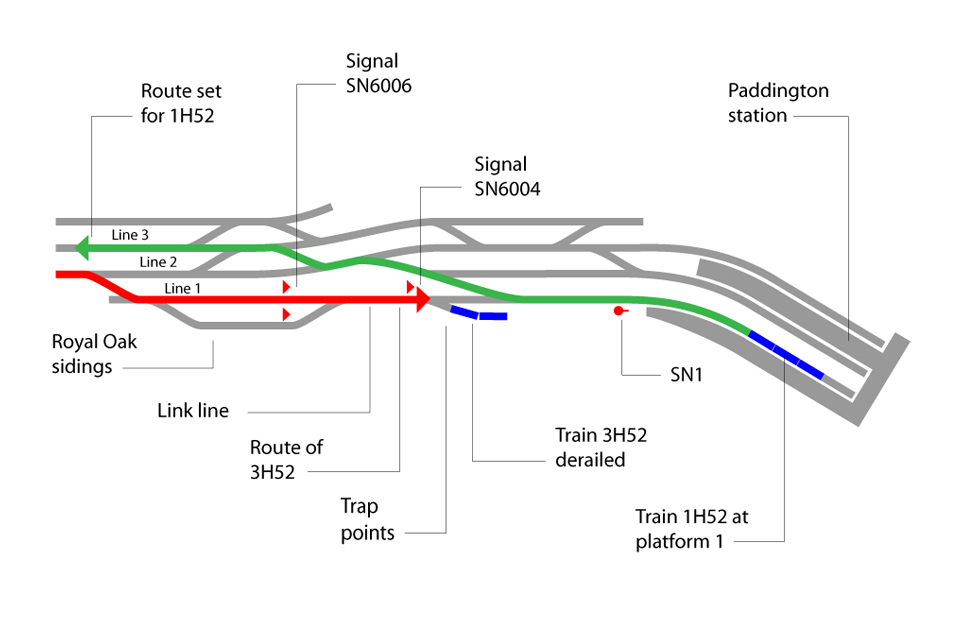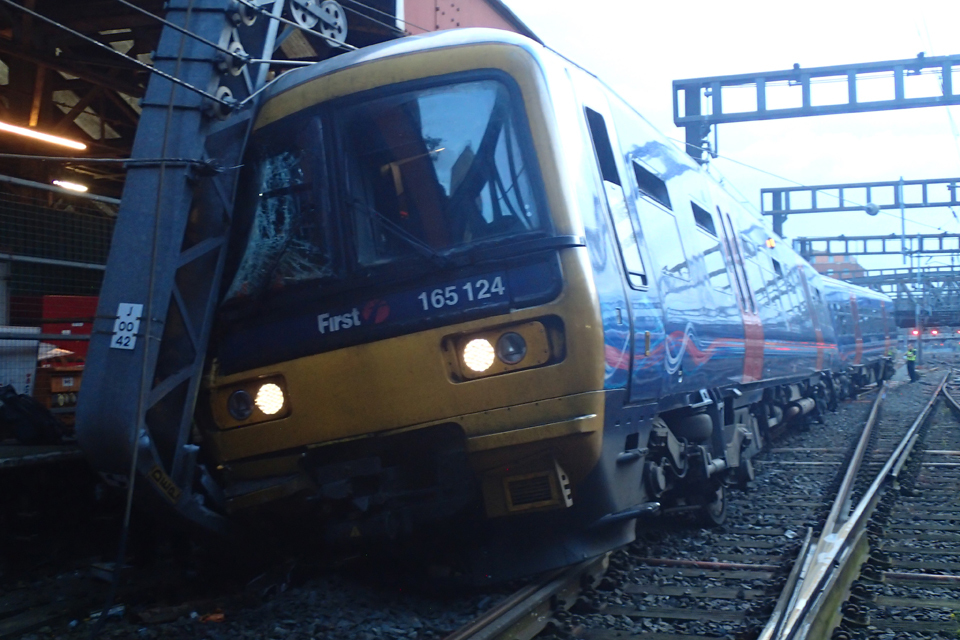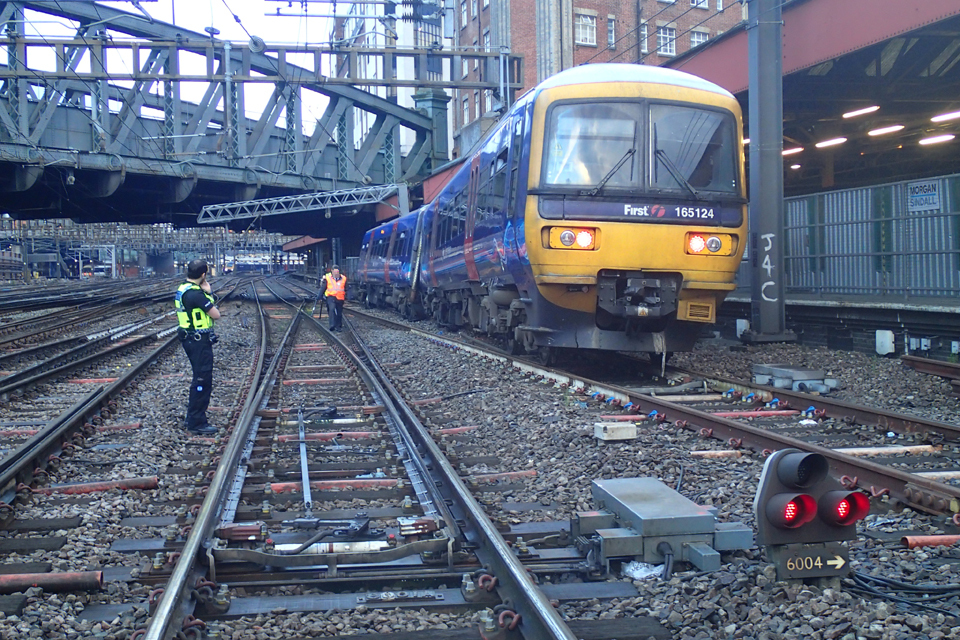Derailment at Paddington, 16 June 2016
Published 18 August 2016
1. Important safety messages
This accident demonstrates the importance of:
- Drivers using the resources available to them to refresh their knowledge of the details of the track layout and signals on routes which they do not drive over regularly, and using reminders such as route diagrams to check what they are about to encounter, before setting off over the route.
- Assessing the risks of using trap points to protect lines and why assessments should include an examination of the potential consequences of derailing, such as the possibility of vehicles fouling running lines or encountering other hazards.
- Drivers being alert to the possibility that, when a position-light signal is cleared the route may only be set as far as another position-light signal, rather than to a main signal or buffer stops.
- Signallers complying with any local instructions applicable to clearing position-light signals when a route cannot be set all the way to a main signal or buffer stops.
2. Summary of the accident
At 18:12 hrs on Thursday 16 June 2016, a two-car diesel multiple unit train, operated by Great Western Railway (GWR), was driven through open trap points immediately outside Paddington station and derailed. It struck an overhead line equipment (OLE) mast, damaging it severely and causing part of the structure supported by the mast to drop to a position where it was blocking the lines. There were no passengers on the train, and the driver was unhurt. All the the lines at Paddington were closed for the rest of that evening, with some services affected until Sunday 19 June.
3. Cause of the accident
The daily station working at Paddington includes a number of instances in which trains are lengthened by attaching additional coaches to sets already in the platforms. One of these, in the evening peak, involves trains 5H52 and 3H52, which are planned to couple in platform 1 to form train 1H52, the 18:12 hrs service to Henley-on-Thames. Train 5H52 is formed of a three-car unit which, having arrived earlier in passenger service from Bedwyn, runs out of platform 1 into Royal Oak Sidings at 17:18 hrs, and should wait in the sidings until 17:42 hrs, and then return to platform 1. Train 3H52 runs empty from Reading depot, and is timetabled to wait on the reception line at Old Oak Common depot until 17:40 hrs, and then run directly to Paddington platform 1, arriving at 17:51 hrs and then attaching to 5H52. However, on occasions train 3H52 may be routed into Royal Oak sidings to wait there for the route into platform 1 to become available; this is what happened on 16 June.

The approaches to Paddington station platform 1 showing the routes set for trains 3H52 and 1H52 and the position of the trains after the accident (not to scale)
Train 3H52 arrived at Royal Oak sidings at about 17:34 hrs, and soon after that there was a change to the planned workings. GWR decided at short notice, in response to increased passenger flows, that 3H52 should be used to lengthen train 1D61, the 18:18 hrs service to Oxford, rather than its planned use on 1H52. This decision was communicated to the signaller on the Paddington workstation at Network Rail’s Thames Valley Signalling Centre (TVSC) at about 17:40 hrs. At that time 5H52 and 3H52 were in Royal Oak sidings, and train 3D61, the empty carriages to form 1D61, was approaching the sidings from Old Oak Common. Platform 1 was occupied by train 1G60, the 17:42 departure to Cheltenham Spa.
The signaller routed 5H52 out of the sidings and up to signal SN6004, to make space in the sidings for 3D61, while waiting for 1G60 to depart, which it did at 17:50 hrs, eight minutes late. 5H52 then ran into platform 1, to become 1H52. The driver of 3H52, who was still expecting to follow 5H52 into the platform, then called the signaller on the radio to ask what was happening. The signaller told him about the change of plan, and said that train 3H52 would have to wait in the sidings for another twenty minutes, until 1H52, the 18:12 hrs departure, had left Paddington, and then go into platform 1.
At 18:11 hrs the signaller set the route for 1H52 to depart from platform 1. One minute later he cleared ground position-light signal SN6006 for 3H52 to leave the siding. The signal displayed two white lights to the driver, which authorised the train to run along the link line as far as the line was clear, up to a similar position-light signal, SN6004. Train 3H52 would then be ready to run into platform 1 as soon as 1H52 had departed.
The driver of 3H52 started his train a few seconds after signal SN6006 cleared. He drove along the link line towards the station, reaching 25 mph (40 km/h), which is the maximum permitted speed on that line. Although he had not seen a train leave platform 1 since his conversation with the signaller, the driver had formed the impression in his mind that the clearance of signal SN6006 meant that the route was set all the way into platform 1. Signal SN6004 was clearly visible, but the driver did not realise that it applied to his train, so he drove past it although it was showing two red lights, meaning ‘Stop’.
Immediately after he passed the signal the driver realised that his train was being diverted to the right, off the track, and so he made an emergency brake application. However, it was too late to prevent the derailment, and the first three bogies of the train ran off the end of the rails. The right-hand front corner of the train struck the mast of a cantilever structure (J 00 42) which supports OLE on line 1. The impact distorted the mast, and the cantilever dropped far enough to become a hazard for trains travelling on lines 1 and 2. The train was still moving at about 8 mph (13 km/h) when it struck the mast. The trap points diverted the train itself clear of the other running lines, and the derailed vehicles did not obstruct any other routes, so there was no risk of collision with another train.

The front of the derailed train showing damage to the windscreen and the OLE mast after the accident
Train 1H52, departing for Henley-on-Thames, had begun to move along platform 1, when the derailment caused the signal at the end of the platform to revert to red. The driver stopped his train before reaching that signal, and the passengers on the train were able to disembark onto the platform.
The driver of 3H52 had been trained by GWR, and qualified to drive trains in October 2015. During his training he had learned the routes out of Paddington, including the link line and Royal Oak sidings, but he had only driven over the link line once during his training, and on one further occasion since qualifying. He had copies of the line diagram for the route in his bag, and could have referred to them during the period that his train was waiting in the sidings. While his train was waiting in Royal Oak sidings, the driver of 3H52 sat in the passenger accommodation and used an electronic device to access the internet. There is no evidence that this device was used while the driver was in the driving cab of the train, or that it played any part in what happened next.
Among the written special instructions to the signallers at TVSC is one that requires that, when a movement starting from a position-light signal requires to run via another position-light signal before reaching a platform, siding or main aspect signal, the signaller must clear all the intermediate position-light signals in the route first. When it is ‘absolutely essential to route such a movement as far as an intermediate position-light signal only’, the signaller is required to reach a clear understanding with the driver before the movement starts. Managers at TVSC said that strict compliance with this instruction is not possible at Paddington, because the station is very busy. However, the conversation between the signaller and the driver should have resulted in the driver understanding that his train could not enter the station until the 18:12 hrs departure had left.

The train from the rear after the derailment. Signal SN6004 showing two red lights is at the bottom right. A BTP officer and member of railway staff are show walking on the ballast
The driver of train 3H52 told RAIB that he had woken during the night before the accident at 02:30 hrs, to eat a light meal, as part of his observance of Ramadan. He went back to bed at 03:30 hrs, slept for a further seven hours before coming on duty at 13:07 hrs, and had not had anything else to eat or drink before the accident occurred. From the evidence available, RAIB is unable to determine whether this interruption to his sleep, and subsequent fasting, was a factor in what happened on this occasion. However, RAIB observes that there is research showing that fasting can affect people’s concentration levels. RSSB has published guidance for the railway industry on the topic in document S220 ‘Effects of fasting on fitness to drive’.
4. Previous similar occurrences
The secondary risks that can result from the use of trap points to reduce the risk from overruns are discussed in our Bury safety digest. These risks were are also referred to in our Carrbridge investigation report.
The OLE mast that was struck by the train is positioned 46 metres, the length of a two-car train, beyond the toe of the trap points. Network Rail’s standard for the provision of trap points (former Railway Group Standard GK/RT0064) requires trap points to be located so as to guide derailed vehicles away from other lines, structures, and any other hazards. In the congested area close to Paddington station, there is little scope for varying the relative positions of trap points and OLE structures, and the distance available beyond these trap points would normally have been regarded as sufficient for a train that derailed on them to be stopped. In this case, because the train was travelling at the maximum permitted speed, and its brakes were not applied until after it had derailed, the space was not sufficient and the structure was damaged.
The importance of route knowledge for train drivers, with reference to the Paddington area, is discussed in Lord Cullen’s report on the accident at Ladbroke Grove on 5 October 1999. While train drivers may be able to regularly drive the running lines on the routes which they sign, it can be difficult to maintain familiarity with all the associated sidings and shunt movements. In such circumstances it is important that drivers have access to, and make use of, reference material such as diagrams of the lines and signals, to remind themselves of the signals applying to shunt moves before they start the movement.
You can print this safety digest.

